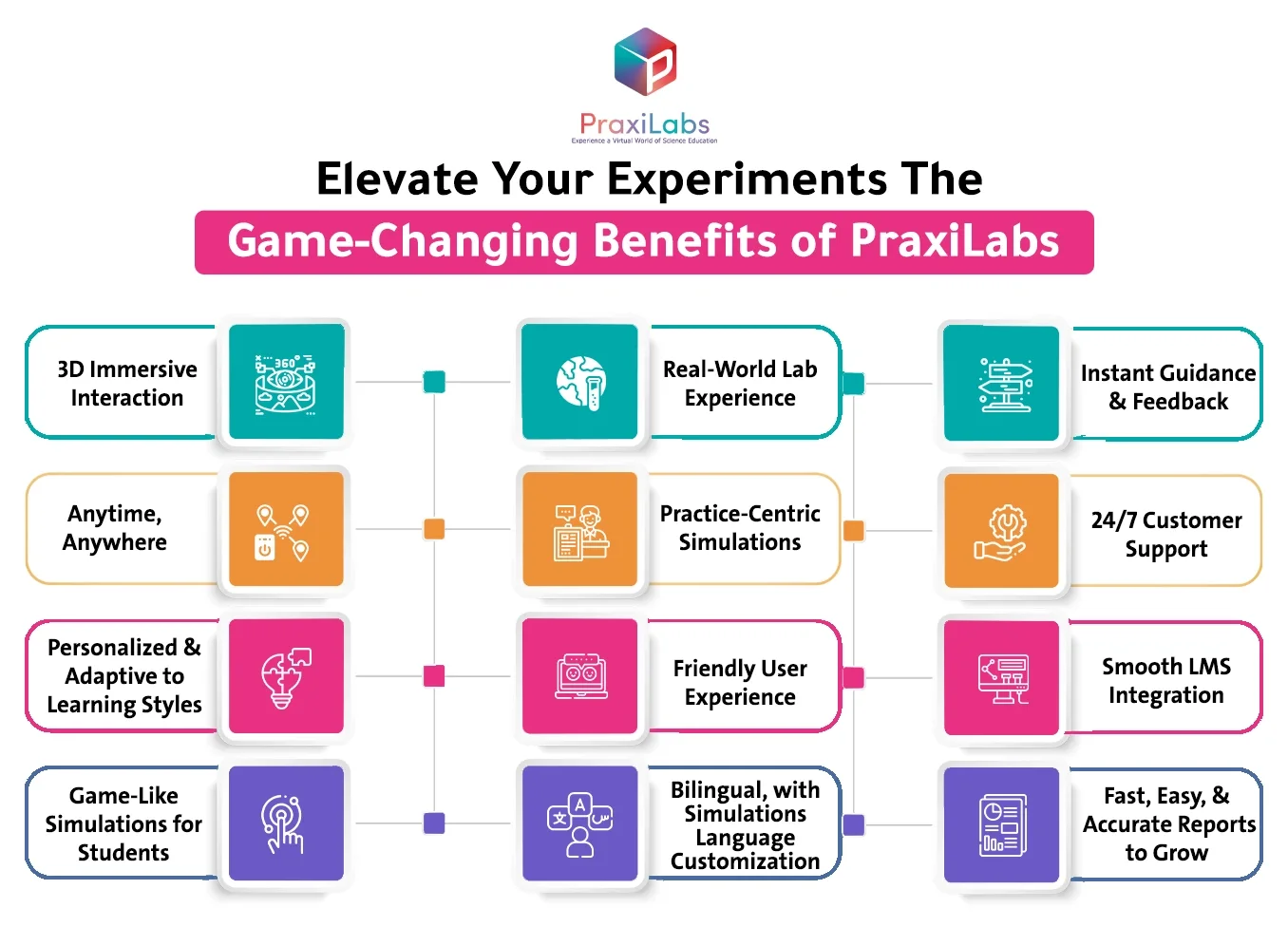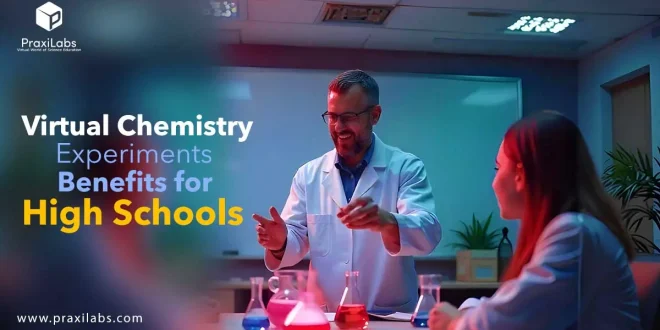Last Updated on September 17, 2025 by Muhamed Elmesery
Conducting virtual chemistry experiments using virtual lab simulations provides several benefits for both students and educational institutions, let’s explore how!
In this blog post, we will learn more about the benefits of virtual chemistry labs for high school students, success factors in virtual chemistry experiments labs, best platform for them, and more!
Table of Contents
What is Virtual Chemistry Experiments?
Virtual chemistry experiments are simulations that recreate the real chemistry labs but in a virtual environment. Students can conduct any dangerous experiment without fear as they do them online away from risks. Students can carry out experiments by online chemistry lab simulator in several sub-disciplines such as:
- Organic chemistry.
- Inorganic chemistry.
- Analytical chemistry.
- Physical chemistry.

Benefits of virtual chemistry labs for high school students
Just imagine your students can conduct any experiment anytime, anywhere, and as many times as they want, in a safe environment without any risks such as exposure to, or inhalation of or contact with toxic chemicals.
By using virtual chemistry 3D labs for high school students, your students will be able to:
- Repeat any experiments they conduct several times, so they will become more familiar with the scientific concept and steps of the experiments.
- Acquire the skills to perform the experiment in a real lab once they understand the steps involved in the procedure.
- Understand several chemical reactions and protocols such as neutralization reactions, acid-base titrations, and more!
- Compare members of chemical groups members in terms of chemical structures, properties and reactions.
- Experimentally identify several radicals containing salts.
- Balance the chemical equations of the reactions they study.
- Understand various tests used to identify the cation or anion present in a given salt.
- Understand the chemical reactions that take place during each test they do.
Try PraxiLabs and Experience a Virtual World of Science Education
Pick the Best Virtual Plan or You
Success factors in Virtual Chemistry Experiments Labs
Here are key success factors in virtual chemistry experiment labs, which determine their educational effectiveness, adoption, and long-term value:
1. Scientific Accuracy and Realism
Simulations must accurately replicate real chemical reactions, lab techniques, and processes with high fidelity.
Results should be predictable and consistent, closely mimicking real-world experimental outcomes.
2. Interactive and Immersive Design
A virtual lab must offer hands-on experiences, students should mix chemicals, adjust variables, and observe outcomes.
The use of 3D environments, animations, and instant feedback enhances engagement and learning outcomes.
3. Curriculum Alignment
Content must align with national and international academic standards. Clear learning objectives, experiment procedures, and integrated assessments are essential.
4. Ease of Use and Accessibility
The user interface should be intuitive and user-friendly for both students and educators. The platform must be accessible across devices and operating systems, including mobile devices and low-bandwidth environments.
5. Safety and Error-Free Environment
One major value is enabling students to experiment with hazardous chemicals safely. Clear instructions and error messages should help learners correct mistakes and understand outcomes.
6. Teacher Support and Integration Tools
Should include lesson plans, teacher dashboards, and customizable experiment settings. Easy LMS integration (e.g., Moodle, Blackboard) is crucial.
7. Scalability and Customization
Virtual chemistry experiments should be scalable for different class sizes and educational levels. Customizable scenarios and content allow educators to tailor the learning experiences.
8. Data Tracking and Analytics
Tracking student performance over time supports personalized learning and institutional reporting.
Best Platform for Virtual Chemistry Experiments
PraxiLabs is the best platform for virtual chemistry experiments. PraxiLabs is a leading e-learning company that provides interactive 3D virtual lab chemistry simulators that are safe, affordable, and accessible anytime, anywhere for educational institutions and students in more than 20 science branches.
PraxiLabs was built, and is continuously developed and improved, by a dedicated team of programmers and education specialists who understand the importance of experimentation in science education. Over 1 million students and 100 educational institutions are benefiting from our chemistry simulations.
PraxiLabs not only offers more than 200 immersive virtual lab experiences, but also addresses key challenges that face students in science education. It provides enriched content that provides students with more understanding and knowledge.
Elevate your students’ Learning Retention and Engagement with PraxiLabs’ Chemistry virtual labs!

3D Virtual Chemistry Experiments Examples in Praxilabs
PraxiLabs introduce a diverse catalog of 3D science experiments including virtual chemistry experiments for students and educational organizations
The 3D virtual chemistry experiments currently cover topics in several sub disciplines such as analytical chemistry, organic chemistry, inorganic chemistry, general chemistry, and safety. Without the hazards or high costs, students can learn and understand scientific concepts through our virtual chemistry experiments.
Let’s discover them!
Organic Chemistry Virtual Experiments from PraxiLabs
PraxiLabs provides a wide range of advanced experiments in organic chemistry such as:
- Tests for Carboxylic Group.
- Tests for Hydroxyl Group.
- Synthesis of Aspirin.
- Esterification.
- Electrophilic Substitution (Azo Coupling).
- Preparation of B-Naphthyl Acetate.
- Claisen Schmidt Reaction (Mixed Aldol Condensation).
- Preparation of Paracetamol.
- Grignrad preparation (New).
- Preparation of Ethyl Propionate (Propanoic acid ethyl ester) (Fisher Esterification) (New).
Inorganic Chemistry Experiments from PraxiLabs
PraxiLabs provides a large group of inorganic chemistry practical 3D virtual experiments:
- Test for Manganous Radical.
- Barium Confirmatory Test.
- Test for Calcium Radical.
- Test for Sulphite Radical.
- Test for Bromide Radical.
- Test for Magnesium Radical.
- Test for lodide Radical.
- Test for Ammonium Radical.
- Test for Sodium Radical.
- Test for Potassium Radical.
- Flame Test.
Analytical Chemistry Experiments from PraxiLabs
PraxiLabs also provides a variety of analytical chemistry virtual experiments such as:
- Determination of Sulphuric Acid Concentration by Titration.
- Standardization of Sodium Thiosulphate using lodimetric Titration.
- Gravimetric Analysis of Sulphate.
- GC MS Analysis.
- NMR Analysis.
- IR Analysis.
- Strong Acid/Strong Base Titration (HCI/NaOH).
- Weak Base/Strong Acid Titration.
Visit Our Ever-Expanding Catalog of 3D Chemistry Virtual Simulations and Enhance Your Students’ Learning Outcomes!
Frequently Asked Questions
Are virtual chemistry labs effective for learning?
Study examined the effect of a virtual chemistry lab online (VCL) on student achievement among 90 students from three different ninth-grade classrooms (an experimental group and two control groups).
Study data were gathered with pre and post chemical-changes unit achievement (CCUA) test, laboratory equipment test (LET), and unstructured observations.
The collected data were analyzed using SPSS (version 16.0). Comparisons were made within and between groups.
It was concluded that the developed virtual chemistry laboratory software is at least as effective as the real laboratory, both in terms of student achievement in the unit and student’s ability to recognize laboratory equipment.
Can virtual experiments replace physical lab work?
According to a study conducted on the role of computer- based materials for the teaching of developmental biology in order to aid teachers in assessing their value, despite digital tools having value, they should not replace all of the traditional laboratory activities.
Clearly, both virtual labs and traditional labs must be included in laboratory exercises. Relying solely on one or the other is inappropriate.
 PraxiLabs A virtual world of science
PraxiLabs A virtual world of science






